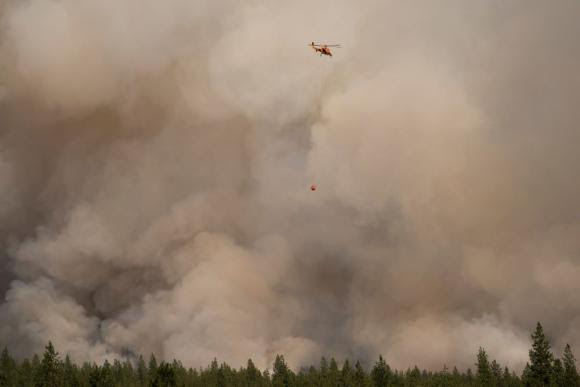Hurricane Helene's multistate path of destructionEarthBeat Weekly October 4, 2024
 A drone view Sept. 29 shows a damaged area in Asheville, North Carolina, following the passing of Tropical Storm Helene. The storm made landfall at 11:10 p.m. (Eastern time) Sept. 27 in Florida's Big Bend as a Category 4 hurricane and was downgraded to a tropical storm the next morning. (OSV News/Reuters/Marco Bello) Hurricane Helene has left a trail of devastation across the Southeast. The 500-mile-wide, category-four storm made landfall in the U.S. on Sept. 26 in Florida's Big Bend region and then moved its way north and inland. Helene is being described as one of the largest storms in the Gulf of Mexico in the last century, with a wind field spanning roughly the distance between Indianapolis and Washington and with maximum sustained winds estimated at 140 mph at its highest point. As of Oct. 4, the death toll across six states had eclipsed 200, with hundreds of people still missing. Meanwhile, millions of people had lost power in the storm's aftermath. In North Carolina, the priests of St. Eugene Parish in Asheville, part of the Charlotte Diocese, were doing their best to help people suffering. The western part of the state saw torrential rains — Asheville received more than 17 inches of rain, while Busick, roughly 40 miles to the northeast, received more than 30 inches by Sept. 28. "Asheville has not experienced such devastating rains, winds, flooding and an almost total breakdown of the infrastructure for over a century," Maryknoll Fr. Doug May told freelance reporter Barb Fraze, speaking by phone from an emergency outpost in downtown Asheville Sept. 30, four days after Helene hit. In the storm's aftermath, St. Eugene Parish was a point place for food and water. Meanwhile, the priests continued administering the sacraments, including two candlelit weddings. "As in most crisis situations, one witnesses the best and worst of humanity. Folks are reaching out to help with food and water while there are fights in lines waiting for gas," May said. Read more: In Tennessee, the small mission parish of St. Michael the Archangel, in Erwin, has become a distribution hub to help people impacted by flooding from Hurricane Helene. Glenmary Br. Corey Soignier told Fraze that people from all over the country had been sending donations. Some came from the Diocese of Owensboro, Kentucky, itself hit hard by tornadoes in 2021. Ursuline sisters were bringing heavy-duty, disaster relief water filters. Some were donating money through Glenmary Home Missioners. By the time the town of just over 6,000 people received the news of the flooding, the storm had passed; the river levels rose as water came rushing down the mountains that surround the town, flooding the Nolichucky River and its tributaries. At the time Soignier spoke with EarthBeat Oct. 1, people could not get to their neighbors stranded in the mountains, but local relief organizations had devised ways to get supplies to those who need them. "We're a small mission parish, but we're doing as much as we can," he said. Read more: Tennessee mission to become post-Helene supply hub: 'We're doing as much as we can' And in Florida, where Helene first struck, four dioceses with substantial coastal exposure along the Gulf of Mexico have been assessing significant flood damage while activating regional distribution centers. Although coastal areas of the Diocese of Pensacola-Tallahassee took a direct hit in terms of the hurricane's landfall, many areas in the diocese and around the South suffered from the heavy storm surge and rain, Tom Tracy reports for OSV News. Many people are in shock now and grieving from such devastating loss, including some 15 Florida Gulf Coast churches with either flooding or roofing damage, according to Teresa Peterson, director of diocesan information and communications for the Diocese of St. Petersburg. Catholic Charities for each of the dioceses is coordinating relief efforts. Peter Routsis-Arroyo, CEO of Catholic Charities of the Archdiocese of Miami, told Tracy that hurricane recovery efforts from last year's Hurricane Idalia were still ongoing in some places, and that the damage he witnessed in the aftermath of Helene suggest a long-term effort that will likely be challenging in light of the storm's equal or greater impact in the Carolinas and Tennessee in particular. "A lot will get routed out of the state of Florida but certainly our dioceses will need help to continue with long-term recovery over the next few years," he said. "This is going to leave the long-term work to be done by agencies such as Catholic Charities in Florida." Read more:
What else is new on EarthBeat: |
In this blog, we'll look at how men and women at serving Jesus Christ both at home and abroad. We'll focus on how God is using their work to transform the lives of people all over the world.
Friday, October 4, 2024
EarthBeat Weekly: Hurricane Helene's multistate path of destruction
Subscribe to:
Post Comments (Atom)
WCC NEWS: WCC extends congratulations to the Evangelical Lutheran Church in Jordan and the Holy Land on consecration of Bishop-Elect Rev. Dr Imad Musa Haddad
World Council of Churches (WCC) general secretary Rev. Prof. Dr Jerry Pillay extended congratulations to the Evangelical Lutheran Church in ...

-
Genocide, Worker Rights, and White Christian Nationalism NCC Newsletter July 2, 2021 Click here to donate Recent Interview with Jim Winkl...
-
Proud Boys Lose Control of Their Name to a Black Church They Vandalized By Alan Feuer, New York Times The Proud Boys no longer have control ...
-
Earlier this week, White House Press Secretary Karoline Leavitt released a list of the"insane priorities" of USAID to justify Elon...











No comments:
Post a Comment